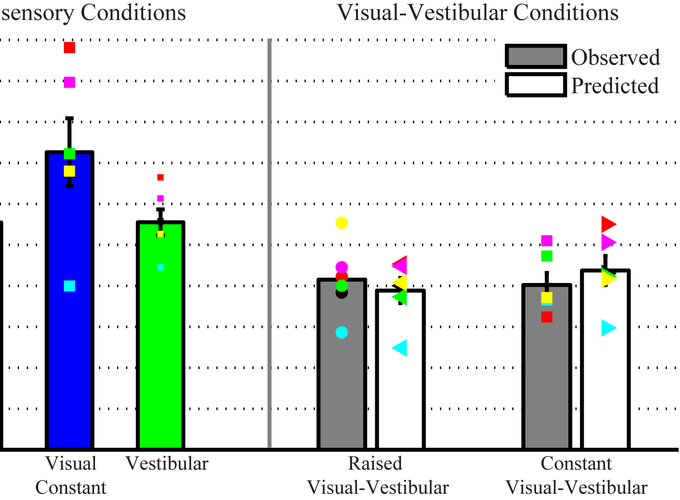Optimal visual–vestibular integration under conditions of conflicting intersensory motion profiles
Abstract
Passive movement through an environment is typically perceived by integrating information from different sensory signals, including visual and vestibular information. A wealth of previous research in the field of multisensory integration has shown that if different sensory signals are spatially or temporally discrepant, they may not combine in a statistically optimal fashion; however, this has not been well explored for visual–vestibular integration. Self-motion perception involves the integration of various movement parameters including displacement, velocity, acceleration and higher derivatives such as jerk. It is often assumed that the vestibular system is optimized for the processing of acceleration and higher derivatives, while the visual system is specialized to process position and velocity. In order to determine the interactions between different spatiotemporal properties for self-motion perception, in Experiment 1 we first asked whether the velocity profile of a visual trajectory affects discrimination performance in a heading task. Participants performed a two-interval forced choice heading task while stationary. They were asked to make heading discriminations while the visual stimulus moved at a constant velocity (C-Vis) or with a raised cosine velocity (R-Vis) motion profile. Experiment 2 was designed to assess how the visual and vestibular velocity profiles combined during the same heading task. In this case, participants were seated on a Stewart motion platform and motion information was presented via visual information alone, vestibular information alone or both cues combined. The combined condition consisted of congruent blocks (R-Vis/R-Vest) in which both visual and vestibular cues consisted of a raised cosine velocity profile and incongruent blocks (C-Vis/R-Vest) in which the visual motion profile consisted of a constant velocity motion, while the vestibular motion consisted of a raised cosine velocity profile. Results from both Experiments 1 and 2 demonstrated that visual heading estimates are indeed affected by the velocity profile of the movement trajectory, with lower thresholds observed for the R-Vis compared to the C-Vis. In Exp. 2 when visual–vestibularinputs were both present, they were combined in a statistically optimal fashion irrespective of the type of visual velocity profile, thus demonstrating robust integration of visual and vestibular cues. The study suggests that while the time course of the velocity did affect visual heading judgments, a moderate conflict between visual and vestibular motion profiles does not cause a breakdown in optimal integration for heading.
